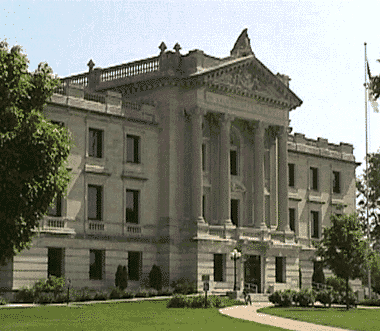|
Looking Back at the DeKalb County Courthouse
by Ron Klein and Mac McIntyre

The DeKalb County Courthouse stands as a silent witness to 93 years of the county's history. It is not the original courthouse. It is the third generation, "born" in 1905 at a price of around $100,000. Somewhere within the four fluted columns, in the walls made of Bedford buffed stone, lies a testimony of the fortitude of Sycamore's founding fathers.
Not everyone thought it a good idea for the courthouse to be located in Sycamore. There were numerous efforts to have the courthouse, and the designation as DeKalb County's seat, placed in other communities. Some have called these efforts "skullduggery," but the verdict handed down in history reflects that Sycamore is the county seat and home of one of the grand courthouses in the country.
If Dr. Henry Madden had had his way, the courthouse would sit in Brush Point, which was just a little northwest of Sycamore (then called Orange). Rufus Colton thought Coltonville was the ideal location for the county seat. Rufus thought he had the inside track. After all he was the Circuit Clerk and court sessions were held at his residence.
The county had just been formed in 1837 and the title of county seat was coveted. Rufus went so far as to hold an election to determine the site of the county seat ó without bothering to notify anyone who was not a resident of Coltonville. This maneuver was cancelled by an act of the Illinois Assembly and finally Sycamore was chosen as the county seat. Perhaps Madden and Colton were right to put so much effort into gaining the title of county seat for their communities. Brush Point and Coltonville did not last long after the decision was made in favor of Sycamore.
A log structure, serving as the courthouse, was erected in 1839. For 11 years this two story building, located across State Street from the present courthouse, kept an increasingly busy schedule. By 1850 the county had grown substantially and the need for a new courthouse was evident. E.P. Young, Kimball Dow and J. C. Kellogg were appointed to contract for the new building at a cost not to exceed $6,000. An addition to the second courthouse was constructed in 1863, and it served the county well up to the turn of the century.
The present courthouse was built amidst controversy as another attempt was made to wrestle the title of county seat away from Sycamore. Two wealthy industrialists from DeKalb, Jacob Haish and Isaac Ellwood, pledged $20,000 each to help defray the costs of building a new courthouse, to be built in DeKalb. Residents of Sycamore collectively raised $70,000 to keep the courthouse in town. Despite legal fights and escalating pledges (Jacob Haish once pledged $103,000 of his own money) the county seat remained in Sycamore and the present courthouse was constructed.
|



